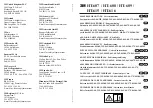
w w w . u q d e v i c e s . c o m
L o g i c 1 6 U s e r M a n u a l
| 50
pos
neg
pos
Coincidence Pattern
Coincidence Event
1
0
0000000000000001
Singles of input 1
2
0
0000000000000010
Singles of input 2
4
0
0000000000000100
Singles of input 3
8
0
0000000000001000
Singles of input 4
3
0
0000000000000011
Coincidence of input 1 and 2
7
0
0000000000000111
Coincidence of inputs 1, 2, and 3
3
4
0000000000000011
Coincidence of inputs 1 and 2 without interaction of input 3
CalcCountPos(int pos)
This method equals CalcCount except that the neg parameter is always 0. It has better run time.
Syntax:
C#
myLogic.CalcCountPos(int pos)
C++
logic.CalcCountPos(int pos)
GetTimeCounter()
The time counter measures the time between the last two calls to ReadLogic. The result is given in
multiples of 5 ns. The time when ReadLogic() is called will vary over time because of the limited realtime
performance of personal computers. The correct count rates can be obtained when the count values from
CalcCount are divided by the result from GetTimeCounter().
Syntax:
C#
myLogic.GetTimeCounter()
C++
logic.GetTimeCounter()
Outputs
SetOutputEventCount(int events)
This function is an advanced feature that can be used to fine tune the delay of the outputs. Roughly
speaking, events is the number of events you expect to occur in one 5 ns time slice under worst-case
conditions.
Increasing the value by one will increase the delay of the outputs by 10 ns. With the standard setting of 5
the output delay will be 350 ns.
When the input rate is too high for the given event count, the OutTooLate Error Flag will be raised. No
output pulse will be generated in this condition. There is never an output pulse generated in the wrong
timing. For this reason OutTooLate is more a kind of warning, not a hard error condition. It just means
that not all pulses are generated.











































